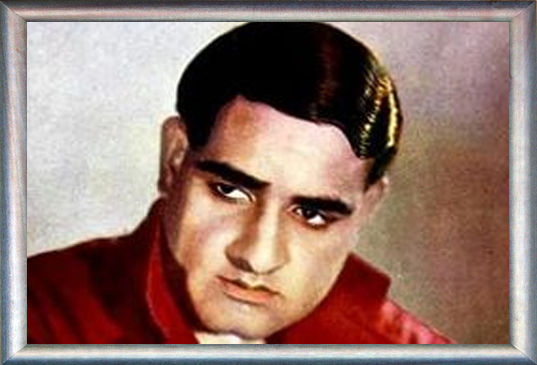Recognized as the greatest singer of the century, K L Saigal was a musical genius who became a legend in his life time. He brought music to the masses and with his God-gifted voice and unique style gave a totally new dimension to the music of his time. His unforgettable melodies continue to enthrall millions of listeners and have become a part of our heritage.
Kundan Lal Saigal was born on 4th April 1904 at Nawa Shaher in Jammu. His father Amar Chand Sehgal was a Tehsildar in the court of the then state of Jammu. His mother Kesar Kaur was a deeply religious lady who was very fond of music. She used to take young Kundan to various religious functions where Bhajans, Keertan and Shabads were sung in traditional styles. Kundan often accompanied his father to the interior parts of the State where he would drink deep into the folk music of Punjab and Kashmir straight from the shepherds and wandering minstrels. He did not have a formal training in classical music nor had a Guru but his extraordinary musical perception made him absorb the notes that went into his ears and responded to all technical musical needs as a singer. His only formal training apparently came from a little known Sufi peer, Salman Yussuf.
The singing tradition he assimilated had little classical rigour but emphasized the poetic blending of syllables into musical forms like the thumri and ghazal. His renditions of Mirza Ghalib's poetry and his identification with its tragic iconography formed the famous Saigal persona. A school dropout, he worked first as a railway time-keeper and then as a typewriter salesman and hotel manager when
B N Sircar of Calcutta's
New Theatre discovered him.
At
New Theatre he came in contact of
R C Boral who was the music director of
New Theatre. Boral identified the talent of the young man and he employed him at
New Theatres on contract basis. His first film was Mohabbat Ke Aansoo (1932), which didn’t helped him in anyway. After the failure of his first film he came out with Subah Ka Taara and Zinda Laash, but, unfortunately both the films failed. In 1933, with the release of Puran Bhagat he tasted success. 'Bhaju Main Bhaav Se..', a bhajan, sung by him became a hit and he came into news nation wide. Same year his Yahoodi Ki Ladki got released which again proved lucky for him. Next year, in 1934, Chandidas earned him the much waited fame and stardom. The real breakthrough came with the film Devdas, directed by P C Barua, in 1935, which established K L Saigal as the first superstar of the Indian Cinema. It created history. Saigal brought alive the character of Devdas creating the archetype of the relentlessly luckless, tragic hero. Songs of Devdas like 'Baalam Aan Baso More Man Me..' and 'Dukh Ke Din Ab Beetat Nahin..' became very popular. In the latter song Saigal obliterates the artificial barriers that separate prose, recitation and song as he breaks the melodic progression of the song by laughing bitterly at his own squalour. In fact, Saigal remains the definitive Devdas even though the role has subsequently been played by such thespians like Dilip Kumar, A. Nageshwara Rao and Shahrukh Khan.
K L Saigal with co-star
Khursheed success followed success and a number of successful movies came out with Saigal in the main lead. Films like Karwan-e-Hayat (1935), Krorepati (1936), Pujarin (1936), President (1937), Dharti Mata (1938), Street Singer (1938), Dushman (1939), Zindagi (1940), Lagan (1941) and My Sister (1944) were lapped by the audience mainly for Saigal songs. Notable among the Bangla films are Jeeban Maran and Saathi.
In 1941 Saigal moved to Bombay to work with
Ranjit Movietone, where he did films like Bhakt Surdas and Tansen, both were very successful. However, by now Saigal’s dependence on alcohol had started affecting his work and his health. People said he could not sing without drinking. In 1947 Saigal passed away in his hometown when he was just 42. Music director
Naushad for whom he did his last film Shajahan, pleaded with him to give up drinking but it was too late. It was said he could only sing only when fortified with liquor. His health began failing. A last ditch effort at abstinence proved useless as he was too far-gone and in early 1947 Saigal passed away in Jallandher. But not before giving us such melodic gems like 'Mere Sapnon Ki Rani..', 'Ae Dil-e-Bekaraar Jhoom..', 'Jab Dil hi Toot Gaya..' from Shah Jahan (1946).
Saigal is said to have been a very simple person who enjoyed his singing extremely and was quite happy to sing for anyone, at any time without any consideration for personal gain. Music was his life and soul. He sang for himself, more like a Sufi saint, finding in music the most effective instrument for sublime communion with the Ultimate. A great artist, a great man, Saigal belongs to the class of human beings who defy death. He is immortal.
Saigal acted in 36-feature films- 28 Hindi, 7 Bangla and 1 Tamil. After Saigal’s death, based on life and times of K. L. Saigal,
B. N. Sircar made film 'Amar Sehgal' (1955). The film contained 19 songs lifted from old films of Saigal. In all, Saigal rendered 185 songs which includes 142 film songs and 43 non-film songs. In the film songs category, there are 110 Hindi, 30 Bangla and 2 Tamil songs. In the non-film category, there are 37 Hindi and 2 each in Bangla, Punjabi and Persian languages.

